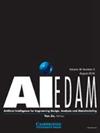Gamification of design thinking: a way to enhance effectiveness of learning
IF 2.3
3区 工程技术
Q3 COMPUTER SCIENCE, ARTIFICIAL INTELLIGENCE
Ai Edam-Artificial Intelligence for Engineering Design Analysis and Manufacturing
Pub Date : 2022-09-29
DOI:10.1017/S0890060422000154
引用次数: 1
Abstract
Abstract The goal of this paper is to develop and test a gamified design thinking framework, including its pedagogical elements, for supporting various learning objectives for school students. By synthesizing the elements and principles of design, learning and games, the authors propose a framework for a learning tool for school students to fulfil a number of learning objectives; the framework includes a design thinking process called “IISC Design Thinking” and its gamified version called “IISC DBox”. The effectiveness of the framework as a learning tool has been evaluated by conducting workshops that involved 77 school students. The results suggest that the gamification used had a positive effect on the design outcomes, fulfilment of learning objectives, and learners' achievements, indicating the potential of the framework for offering an effective, gamified tool for promoting design thinking in school education. In addition to presenting results from empirical studies for fulfilment of the objectives, this paper also proposes an approach that can be used for identifying appropriate learning objectives, selecting appropriate game elements to fulfil these objectives, and integrating appropriate game elements with design and learning elements. The paper also proposes a general approach for assessing the effectiveness of a gamified version for attaining a given set of learning objectives. The methodology used in this paper thus can be used as a reference for developing and evaluating a gamified version of design thinking course suitable not only for school education but also for other domains (e.g., engineering, management) with minimal changes.设计思维游戏化:提高学习效果的途径
摘要本文的目标是开发和测试一个游戏化的设计思维框架,包括其教学元素,以支持学生的各种学习目标。通过综合设计、学习和游戏的元素和原则,作者为学生提供了一个学习工具框架,以实现一些学习目标;该框架包括一个名为“IISC设计思维”的设计思维过程及其游戏化版本“IISC DBox”。通过举办有77名学生参加的讲习班,对该框架作为一种学习工具的有效性进行了评估。结果表明,所使用的游戏化对设计结果、学习目标的实现和学习者的成就产生了积极影响,这表明该框架有潜力在学校教育中提供一种有效的游戏化工具来促进设计思维。除了介绍实现目标的实证研究结果外,本文还提出了一种方法,可用于确定适当的学习目标,选择适当的游戏元素来实现这些目标,并将适当的游戏因素与设计和学习元素相结合。本文还提出了一种评估游戏化版本实现给定学习目标的有效性的通用方法。因此,本文中使用的方法可作为开发和评估游戏化版本的设计思维课程的参考,该课程不仅适用于学校教育,也适用于其他领域(如工程、管理),变化最小。
本文章由计算机程序翻译,如有差异,请以英文原文为准。
求助全文
约1分钟内获得全文
求助全文
来源期刊
CiteScore
4.40
自引率
14.30%
发文量
27
审稿时长
>12 weeks
期刊介绍:
The journal publishes original articles about significant AI theory and applications based on the most up-to-date research in all branches and phases of engineering. Suitable topics include: analysis and evaluation; selection; configuration and design; manufacturing and assembly; and concurrent engineering. Specifically, the journal is interested in the use of AI in planning, design, analysis, simulation, qualitative reasoning, spatial reasoning and graphics, manufacturing, assembly, process planning, scheduling, numerical analysis, optimization, distributed systems, multi-agent applications, cooperation, cognitive modeling, learning and creativity. AI EDAM is also interested in original, major applications of state-of-the-art knowledge-based techniques to important engineering problems.

 求助内容:
求助内容: 应助结果提醒方式:
应助结果提醒方式:


